Kennin-ji Temple
建仁寺
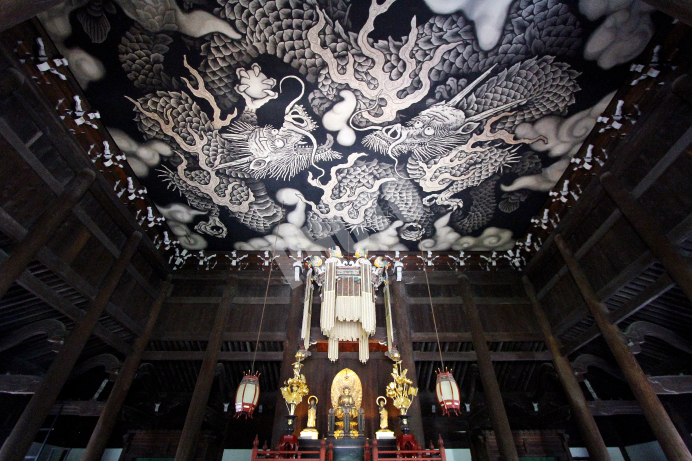
Kennin-ji Temple, established in 1202 by the revered monk Eisai, was founded with support from Minamoto no Yoriie, the second Shogun of the Kamakura shogunate. Named after the era it was founded in, the Kennin Era, the temple stands as a symbol of Japan’s rich Zen tradition. In the 14th century, under the guidance of Ashikaga Yoshimitsu, the third Shogun of the Muromachi shogunate, Kennin-ji became ranked third in Kyoto's prestigious Gozan (Five Great Zen Temples) system.
Kennin-ji is also known for its exceptional contributions to Zen scholarship. Many distinguished scholars and poets in Chinese literature emerged from Kennin-ji, lending it a reputation as a center for academic excellence.
One of the temple’s greatest attractions is its treasured art collection. Here, visitors can witness the famous “Fujin Raijin-zu” (Wind and Thunder Gods) folding screen by the iconic artist Tawaraya Sotatsu. The temple also houses dynamic wall paintings by Kaihō Yūshō, including the impressive “Unryu-zu” (Cloud Dragon) that adorns its sliding doors.
Located in Kyoto’s Gion district, Kennin-ji Temple is a must-visit for those interested in experiencing the spiritual and artistic legacy of Japan’s oldest Zen temples. Visitors are encouraged to explore the beautiful Zen gardens and immerse themselves in the tranquil atmosphere that has drawn travelers for centuries.
| Sect | Rinzai Zen |
|---|---|
| Location | 584 Komatsu-cho, Yamatooji-dori Shijo-sagaru, Higashiyama-ku, Kyoto, 605-0811, Japan |
| Contact | 075-561-0190 |
| Visiting Hours | 10:00~17:00(Last Admission at 16:30) |
| Map | |
|---|---|
Highlights of Kenninji Temple
One of the main attractions of Kenninji Temple is the Hōjō, where visitors can admire a replica of Tawaraya Sōtatsu's renowned work, "The Wind God and Thunder God" (風神雷神図). The Hōjō also features sliding doors adorned with beautiful paintings by Kaihoku Yūshō, including "The Four Arts of the Scholar" (琴棋書画図襖) and "The Cloud Dragon" (雲龍図襖). In addition to its artistic treasures, the temple grounds include stunning gardens such as the Daio-en, the 〇△□ (Circle, Triangle, Square) Garden, and the Chōon-tei, each offering a unique glimpse into Zen aesthetics. A must-see is the impressive twin dragon painting on the ceiling of the Hōdō, which captivates visitors with its dynamic portrayal. To avoid crowds and enjoy a serene experience, it is recommended to visit early in the day.
Scroll ▶▶
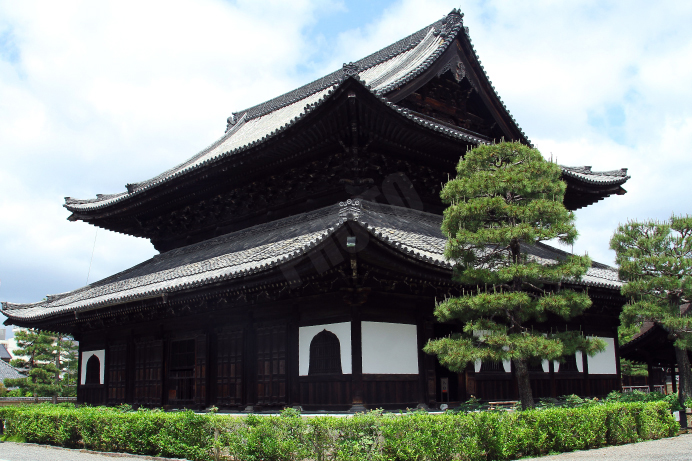
Dharma Hall
法堂
In Kennin-ji Temple's Dharma Hall, you’ll find the seated Shakyamuni Buddha as the principal deity, accompanied by Kashyapa and Ananda as supporting statues, emphasizing the spiritual depth of Zen Buddhism in Kyoto. The ceiling boasts a mesmerizing Twin Dragon mural by renowned artist Koizumi Junsaku, adding to the hall's visual splendor. This hall, an example of Zen temple architecture built in 1765 (Meiwa 2), showcases traditional Buddhist craftsmanship and design that transports visitors back to 18th-century Japan.
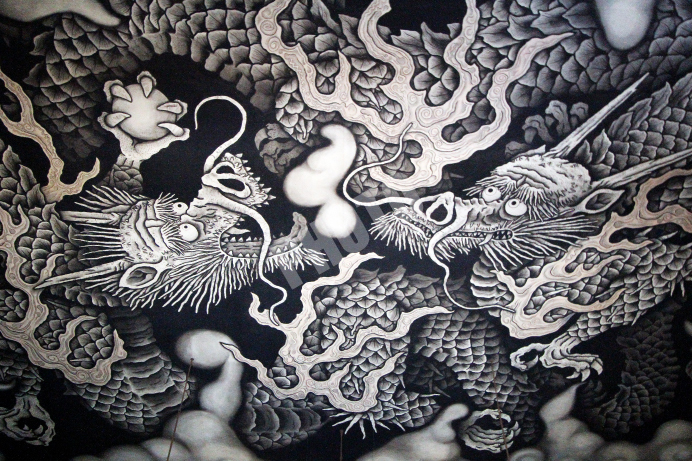
Twin Dragon Mural
双龍図
The Hatto Hall ceiling at Kennin-ji Temple presents a breathtaking display of Twin Dragons, a remarkable 108-tatami-sized ink painting by renowned Japanese artist Junsaku Koizumi. Painted over two years, this masterpiece captures two dynamic dragons in the traditional A-Un stance, facing each other and symbolizing the cosmic concepts of beginning and end in Japanese Zen Buddhism. The intricate detail and grand scale of the artwork create an unforgettable experience for visitors, making it one of Kennin-ji Temple’s most impressive and awe-inspiring features. The Twin Dragons ceiling painting is an essential highlight for those exploring Japanese Zen art, Buddhist symbolism, and Japanese temple architecture.
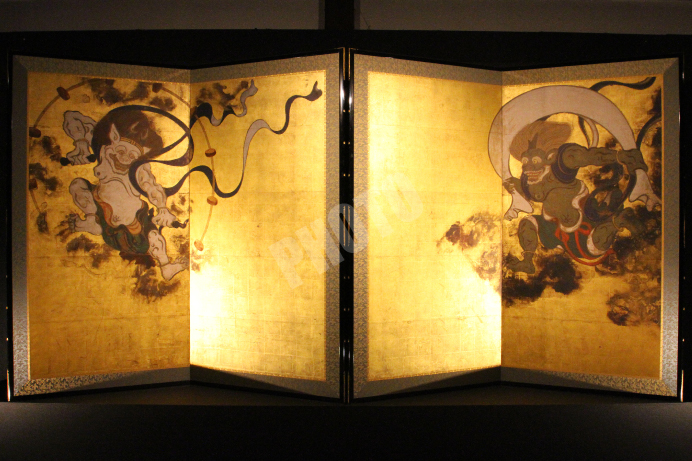
Wind God and Thunder God Screens
風神雷神図
The "Wind God and Thunder God Screens" by Tawaraya Sōtatsu are renowned works of art recognized as a National Treasure of Japan. These screens feature a striking design with gold leaf applied to the background, showcasing the Wind God on the right and the Thunder God on the left. Their unique composition includes a prominent blank space in the center, adding to the overall aesthetic appeal. Visitors can view a high-quality replica of these screens at Kennin-ji Temple, while the original artworks are preserved at the Kyoto National Museum.
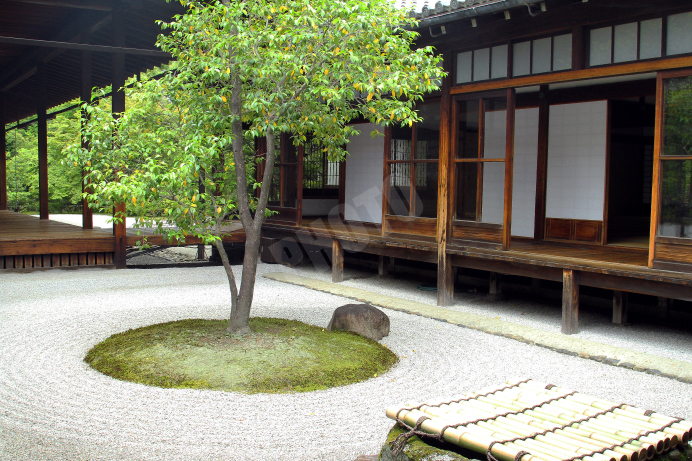
The Garden of Circle, Triangle, and Square
○△□乃庭
The garden is inspired by the Zen painting "〇△□" (Circle, Triangle, Square) created by the Zen monk Sengai Gibon. It was designed by Kitayama Yasuo. In this garden, the square represents a well (井筒), the circle symbolizes a single camellia's base covered in moss, and the triangle is expressed through Shirakawa sand. This design concept reflects Zen aesthetics, emphasizing simplicity and harmony with nature. Each shape embodies specific elements, contributing to the garden's overall tranquility and spiritual significance.
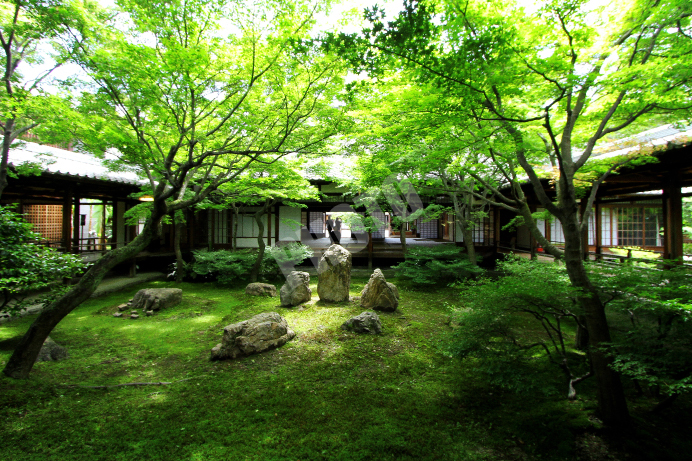
Chōon-tei
潮音庭
Nestled between the Oshoin (Main Hall) and Koshoin (Small Hall), the Shioin Garden is an exquisite Karesansui (dry landscape) garden that spans approximately 170 square meters. The garden's centerpiece is a thoughtfully arranged triad of stones (known as Sanzon-ishi), ingeniously designed to face visitors from any viewpoint, enhancing the immersive experience. This stunning landscape was crafted by the renowned garden designer Kita Yama Yasuo, showcasing a harmonious blend of nature and artistic expression that is characteristic of traditional Japanese gardens.
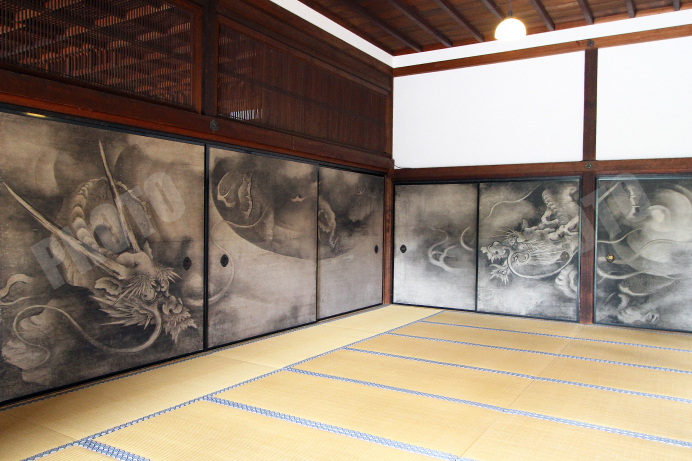
Cloud Dragon Screen
雲龍図襖
The exquisite fusuma paintings created by renowned artist Kaihoku Yūshō were originally located in the Reikan Room at the southeast corner of the Hōjō in Kenninji Temple. Dating back to the Azuchi-Momoyama period, these artworks are not only significant for their artistic value but also hold the distinction of being designated as Important Cultural Properties in Japan.

